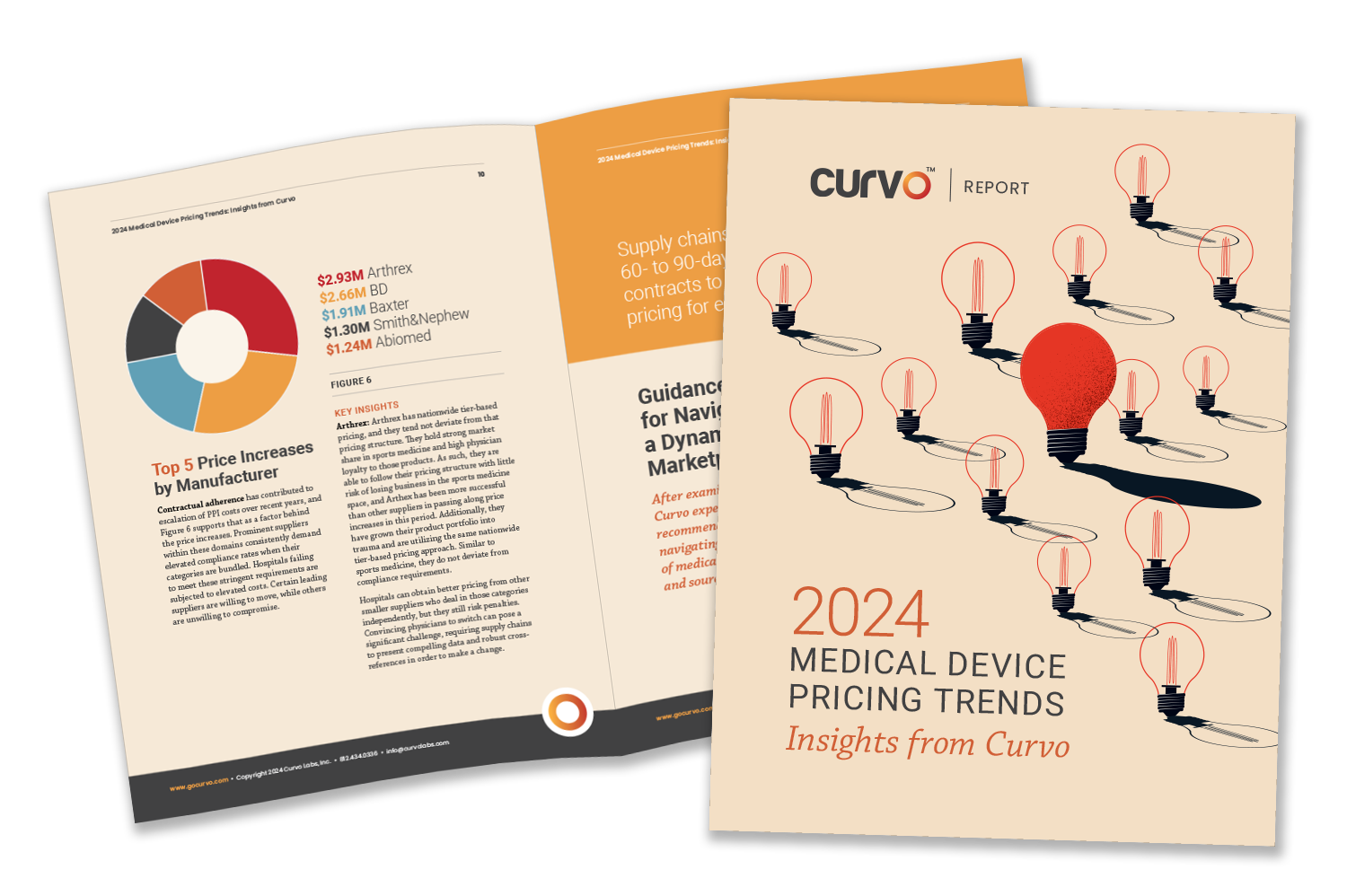Home Blog Curvo Medical Device Pricing Trends Report: 10 Takeaways

Curvo Medical Device Pricing Trends Report: 10 Takeaways
Best Practices Leadership & Strategy
The new 2024 Medical Device Pricing Trends Report reveals substantial savings are possible in medical device contracts. The independent research confirmed over $54 million in annual savings based on actual purchase data from more than 200 hospitals.
Healthcare supply chains, device suppliers, analysts and others will find useful insights for navigating the intricate landscape of medical device pricing and contracts. These 10 takeaways highlight some of the ideas and guidance you’ll find in the report.
1. Price Variations Drawn from Actual PO Data from 200+ Hospitals
At the heart of the report lies a comprehensive analysis derived from historical purchase order (PO) data collected from more than 200 hospitals and healthcare facilities. This extensive dataset supports a nuanced examination of purchasing activity across specific medical device products, facilitating a detailed comparison of pricing trends over time.
By meticulously tracking average price variations between 2022 and 2023, the report offers a holistic view of market dynamics and specific trends, enabling stakeholders to make informed decisions based on real-world data.
2. Top Categories Driving Medical Device Cost Savings and Cost Increases
The report identifies the top five product categories that drove significant cost savings, as well as those responsible for price increases. Additionally, it highlights the top five manufacturers collaborating with hospitals to drive savings. Read on to learn why these are key findings for medical device contract strategies.
3. Watch Pricing Trends for Opportunities to Improve Contracts
Health systems encounter significant savings challenges that are often rooted in information gaps. For example, despite the aggregate $6 million savings seen in CRM purchases in 2023, hospitals may lack awareness of the evolving dynamics within this category.
The report emphasizes the dynamic nature of the medical device marketplace and the need for ongoing analysis. Healthcare systems are encouraged to periodically review high-value categories, even mid-contract, to take advantage of pricing dynamics and negotiate more favorable terms. If one category has moved significantly, that’s an area to look for savings. Even if you're mid-cycle in a contract, call your supplier if the market pricing has changed.
4. Take Advantage of Proactive Medical Device Contract Renegotiation
The insights found in the 2024 Medical Device Pricing Trends Report underscore the importance of proactive management of medical device contracts. Sourcing teams should periodically review high-value categories, even mid-contract, to compare them to evolving pricing dynamics such as in the Pricing Trends Report. The report can show what their peers spent for various medical device categories and, armed with robust data, hospitals can substantiate the need for more favorable pricing.
Periodic scrutiny of high-value categories is recommended to adapt to pricing dynamics. Supply chains can often leverage the 60- to 90-day cancellation clause in contracts to negotiate terms and avoid fixed pricing for extended periods.
5. Use Medical Device Pricing Trends to Focus Sourcing Strategies
Sourcing professionals struggle with questions like “Am I working in the right categories?” or “Am I missing something?” By focusing on the top spending categories noted in the report, organizations can ensure they direct their efforts effectively. The greater the spend volume, the more opportunity to find savings.
Drug-eluting stents, CRM and spine are the top three movers of the period studied, so they're great places to look right now. Note that the report is based on actual purchasing data and actual prices. The report should prompt supply chain leaders to reassess their high-dollar medical device areas when it comes to potential savings.
6. Build Sourcing Partnerships Across Facilities and Suppliers
Substantial savings may be realized by consolidating medical device contracts across different facilities within a healthcare system. One roadblock to this practice has been lack of insight into multiple contracts across the system.
Supply chains can now utilize data and analytics to aggregate information and learn which sites might have individual contracts with the same supplier. Hospitals can consolidate contracts with specific suppliers across different facilities within their network. The greater volume commitment enhances bargaining power.
7. Validate Sourcing Performance to Leadership
Validating performance to organizational leaders is an imperative, especially in areas like supply chain. In environments where accountability is paramount, having robust data to substantiate sourcing decisions and demonstrate adherence to best practices is crucial.
The report shows where savings are being achieved. By comparing their performance against industry peers and identifying areas for improvement, healthcare supply chains can drive continuous optimization and cost savings. Many organizations have turned to Curvo Data Enrichment and Sourcing Analytics for further evidence and tools to focus on profitability.
8. Step Out of Healthcare Sourcing Comfort Zone
Overworked healthcare supply chains often stick with what's familiar or what they have time for, including their medical device sourcing work. Understandably, teams focus on categories that don’t offer as many data challenges. Knee, hip and shoulder products, for example, don't have as many different components and subcategories as other categories.
However, by stepping out of their comfort zones and exploring new avenues for cost optimization, healthcare supply chain managers can unlock hidden value and achieve tangible savings. One such strategy involves leveraging a technology partner for data enrichment and sourcing analytics to uncover savings opportunities in both traditional and overlooked categories.
Peripheral vascular, endomechanical trocar and suture are some of the categories that are harder and more complex to research. By leveraging data enrichment and sourcing analytics, organizations can more easily identify savings in both traditional and overlooked categories.
It’s fine to master those familiar categories, but don’t let lack of data or time be a roadblock to other opportunities. Data enrichment and sourcing analytics can help you step out of your comfort zone.
9. Roll Up Smaller Categories to Build Worthwhile Opportunities
Some overworked teams focus on the same categories all the time: spinal fusion, cardiac rhythm management, total joints and drug-eluting stents. Those are the big, traditional “home run” categories where hospitals spend a lot of money, and that makes them an obvious place for a price reduction strategy. No one should take their eyes off those categories. They represent the biggest spend, so you always want to be looking at the bigger categories that are in the report: CRM, spine, drug-eluting stents. arthroplasty and trauma.
But, the report also underscores the significance of exploring untapped opportunities in smaller spend categories. While larger product categories such as spinal fusion and cardiac rhythm management often receive the lion's share of attention, prioritizing smaller categories can yield substantial savings and contribute significantly to overall cost reduction efforts.
However, pursuing smaller spend categories can be an effective strategy for sourcing success and contribute substantially to overall savings. But unless sourcing teams can easily access the data and analysis to find the opportunities, these smaller categories remain out of reach.
10. Embrace Data-Driven Decision Making for Medical Device Contracts
Most supply chain departments tend to stay away from highly fragmented categories like peripheral vascular, endomechanical, trocar and suture, because collecting and using data across all those subcategories can be difficult.
Curvo’s suite of products and services enable efficient analysis for smaller and highly complex categories . Sourcing experts offer data-driven guidance to navigate the complexities of medical device pricing and sourcing. The data-driven insights are invaluable for healthcare supply chains, finance leaders, purchasing collaborations, medical device suppliers, and others vested in the market.
Read Curvo Medical Device Pricing Trends Report for Sourcing Strategies
By staying abreast of market trends, harnessing the power of data analytics, and fostering strategic partnerships, organizations can position themselves for long-term success and deliver value-driven care to patients worldwide.
The insights presented in the 2024 Medical Device Pricing Trends Report offer a roadmap for navigating the complexities of medical device sourcing today. With data-driven strategies and proactive practices, hospitals can unlock substantial savings and drive operational excellence. Request your copy.

